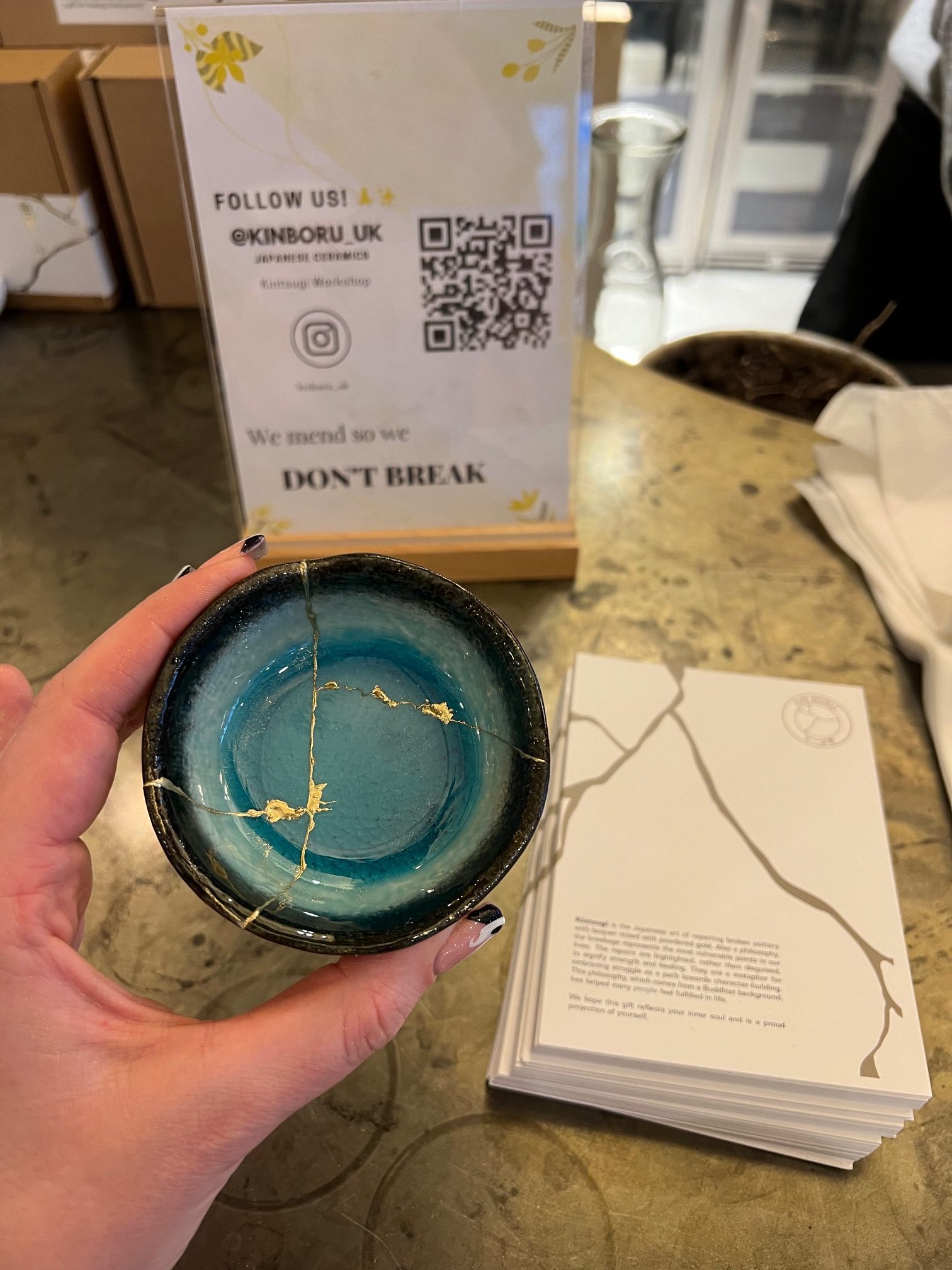A gift I was pleased to receive for Christmas in 2023 was a voucher for a kintsugi workshop in London. It didn’t take me long to find the perfect opportunity to redeem it, here I’ll share how I found the experience…
Awareness of the art of kintsugi is steadily increasing. I first learned about it via social media – it’s the Japanese concept of fixing broken pottery, sealing the cracks with golden liquid to make what was a ruined object even more beautiful than it was before. It serves as a metaphor for the fact that broken doesn’t mean irreparable, and that imperfections have their own appeal. Similarly to other creative pursuits, it can also be a mindful experience for the maker.
Visual art is something that I’ve never taken the time to be good at but, as with sport, we don’t actually have to be “good” at art in order to participate. It’s ok to be a beginner. And it’s also ok to create something that you love but that doesn’t appeal to others – it’s fully subjective and, when you let go of the academic sense of art, that’s very freeing.
Kintsugi workshop in London
Workshops are available on Fridays, Saturdays and Sundays, at a venue near the south side of Tower Bridge. As I was planning to stay overnight in town for a concert, I chose to book my workshop for the following day.
Host and teacher, Brandon, had everything set up and we all received a warm welcome. With aprons and face masks at the ready, we were offered a range of bowls to choose from, before sitting down to begin.
I selected a small bowl with a gorgeous bright blue inner, despite being advised that this was a trickier item! Pottery isn’t food-safe after it has been repaired in this way, so I didn’t want a rice bowl-sized piece, but a smaller one suitable for storing items such as earrings – I was ready for the challenge.
Learning about kintsugi
Brandon began with an explanation of the process. I had assumed that the gold colour comes directly from the liquid used to make repairs, but it in fact works using plain resin, which you then throw gold dust at using a small brush! My friends and family know that I love glitter, so this already seemed like a great way to spend a couple of hours. We were also given a history of the art of kintsugi, which was really interesting and well-delivered.
Step one: smashing
One of the draws of this workshop for me is that you get to smash your chosen piece of pottery yourself! Full tuition was given first, and this is the part that’s more difficult with certain items. I paid attention… then stood back and let the one other participant who had chosen the same item as me go first. The other bonus to hanging back and waiting is that your first step is to tap the side of the bowl until it clicks – the sound is much quieter with a smaller item, so once the noise in the room had died down a bit, I thought that this would be easier…
And I was right. Being gentle with tools doesn’t come naturally to me, so I took a deep breath and followed the instructions to steadily tap my bowl. With moral support from some other attendees, I managed to get my click, and moved on to the next phase. You then have to tap the bottom of the bowl – the click you hear means that the pottery has cracked internally, so you are completing the process with the next tap.
Ideally for this workshop, you want four clean pieces, which I managed to accomplish. Pleased with my effort so far, it was time to move on…
Step two: repairing
We returned to our seats, and were talked through the process of preparing the resin. Brandon teaches family-style, as timing is important, so everyone stirs their resin for an allotted time, waits, and then applies it to a piece of pottery. He advised each of us on which pieces to start with, and what the risks and benefits were of applying more or less resin.
I took the approach of wanting mine to look fairly neat, so I applied as little resin as I thought I could get away with, focusing carefully on the task. Once the resin has been applied, it’s time to throw glitter, which was surprisingly challenging. It’s a very fine powder, and so the inevitable happens and it goes everywhere, but for me this added to the fun.
We worked together until we had all pieces stuck back together, then were told how to clean our piece off and neaten it up before taking it home.
Try kintsugi for yourself
I thoroughly recommend this experience, whether you want to attend alone like I did, or as part of a group. Materials were provided to carefully package our artwork up straight away, and Brandon was happy to help with photos and videos throughout – this is, after all, the digital age. It was a great way to spend a couple of hours, and I may well be back for more…
